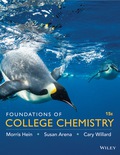
EBK FOUNDATIONS OF COLLEGE CHEMISTRY
15th Edition
ISBN: 9781118930144
Author: Willard
Publisher: JOHN WILEY+SONS INC.
expand_more
expand_more
format_list_bulleted
Question
Chapter 5, Problem 6RQ
Interpretation Introduction
Interpretation:
The difference between a cation and an anion has to be written.
Expert Solution & Answer
Want to see the full answer?
Check out a sample textbook solution
Students have asked these similar questions
what is the skeletal structure of a tertiary alkyl fluoride with six carbon atoms and no rings.
One step of glycolysis is a retro-aldol reaction (aldolase) to produce ATP.Below is the aldol reaction of the equilibrium. Show the mechanism for the base catalyzed reaction. *see image
Provide the missing information. *see image
Chapter 5 Solutions
EBK FOUNDATIONS OF COLLEGE CHEMISTRY
Ch. 5.1 - Prob. 5.1PCh. 5.2 - Prob. 5.2PCh. 5.3 - Prob. 5.3PCh. 5.4 - Prob. 5.4PCh. 5.5 - Prob. 5.5PCh. 5.5 - Prob. 5.6PCh. 5.6 - Prob. 5.7PCh. 5 - Prob. 1RQCh. 5 - Prob. 2RQCh. 5 - Prob. 3RQ
Ch. 5 - Prob. 4RQCh. 5 - Prob. 5RQCh. 5 - Prob. 6RQCh. 5 - Prob. 7RQCh. 5 - Prob. 8RQCh. 5 - Prob. 9RQCh. 5 - Prob. 10RQCh. 5 - Prob. 11RQCh. 5 - Prob. 12RQCh. 5 - Prob. 1PECh. 5 - Prob. 2PECh. 5 - Prob. 3PECh. 5 - Prob. 4PECh. 5 - Prob. 5PECh. 5 - Prob. 6PECh. 5 - Prob. 7PECh. 5 - Prob. 8PECh. 5 - Prob. 9PECh. 5 - Prob. 10PECh. 5 - Prob. 11PECh. 5 - Prob. 12PECh. 5 - Prob. 13PECh. 5 - Prob. 14PECh. 5 - Prob. 15PECh. 5 - Prob. 16PECh. 5 - Prob. 17PECh. 5 - Prob. 18PECh. 5 - Prob. 19PECh. 5 - Prob. 20PECh. 5 - Prob. 21PECh. 5 - Prob. 22PECh. 5 - Prob. 23PECh. 5 - Prob. 24PECh. 5 - Prob. 25PECh. 5 - Prob. 26PECh. 5 - Prob. 27PECh. 5 - Prob. 28PECh. 5 - Prob. 29PECh. 5 - Prob. 30PECh. 5 - Prob. 31PECh. 5 - Prob. 32PECh. 5 - Prob. 33PECh. 5 - Prob. 34PECh. 5 - Prob. 35AECh. 5 - Prob. 36AECh. 5 - Prob. 37AECh. 5 - Prob. 38AECh. 5 - Prob. 39AECh. 5 - Prob. 42AECh. 5 - Prob. 43AECh. 5 - Prob. 45AECh. 5 - Prob. 46AECh. 5 - Prob. 47AECh. 5 - Prob. 48AECh. 5 - Prob. 49AECh. 5 - Prob. 50AECh. 5 - Prob. 51AECh. 5 - Prob. 53AECh. 5 - Prob. 54AECh. 5 - Prob. 55AECh. 5 - Prob. 56AECh. 5 - Prob. 60CE
Knowledge Booster
Similar questions
- Provide the missing information. *see imagearrow_forwardProvide the missing information. *see imagearrow_forwardDraw the mechanism (including all curved arrows for electron movement) showing how the maleicanhydride is attacked by the anthracene and formation of the final Diels Alder product.arrow_forward
- I have a bottle of butanal that has been improperly used by lab workers. They allowed a traceamount NaOH (aq) to contaminate the bottle. What is now in my bottle of “butanal? What is the molecular name and functional group name? Draw the structure.arrow_forwardProvide the missing information. *see imagearrow_forwardFirst image: Why can't the molecule C be formed in those conditions Second image: Synthesis for lactone C its not an examarrow_forward
arrow_back_ios
SEE MORE QUESTIONS
arrow_forward_ios
Recommended textbooks for you
 Living By Chemistry: First Edition TextbookChemistryISBN:9781559539418Author:Angelica StacyPublisher:MAC HIGHER
Living By Chemistry: First Edition TextbookChemistryISBN:9781559539418Author:Angelica StacyPublisher:MAC HIGHER Introductory Chemistry: A FoundationChemistryISBN:9781337399425Author:Steven S. Zumdahl, Donald J. DeCostePublisher:Cengage LearningChemistry: Matter and ChangeChemistryISBN:9780078746376Author:Dinah Zike, Laurel Dingrando, Nicholas Hainen, Cheryl WistromPublisher:Glencoe/McGraw-Hill School Pub Co
Introductory Chemistry: A FoundationChemistryISBN:9781337399425Author:Steven S. Zumdahl, Donald J. DeCostePublisher:Cengage LearningChemistry: Matter and ChangeChemistryISBN:9780078746376Author:Dinah Zike, Laurel Dingrando, Nicholas Hainen, Cheryl WistromPublisher:Glencoe/McGraw-Hill School Pub Co Chemistry: Principles and PracticeChemistryISBN:9780534420123Author:Daniel L. Reger, Scott R. Goode, David W. Ball, Edward MercerPublisher:Cengage Learning
Chemistry: Principles and PracticeChemistryISBN:9780534420123Author:Daniel L. Reger, Scott R. Goode, David W. Ball, Edward MercerPublisher:Cengage Learning World of Chemistry, 3rd editionChemistryISBN:9781133109655Author:Steven S. Zumdahl, Susan L. Zumdahl, Donald J. DeCostePublisher:Brooks / Cole / Cengage Learning
World of Chemistry, 3rd editionChemistryISBN:9781133109655Author:Steven S. Zumdahl, Susan L. Zumdahl, Donald J. DeCostePublisher:Brooks / Cole / Cengage Learning Chemistry: The Molecular ScienceChemistryISBN:9781285199047Author:John W. Moore, Conrad L. StanitskiPublisher:Cengage Learning
Chemistry: The Molecular ScienceChemistryISBN:9781285199047Author:John W. Moore, Conrad L. StanitskiPublisher:Cengage Learning

Living By Chemistry: First Edition Textbook
Chemistry
ISBN:9781559539418
Author:Angelica Stacy
Publisher:MAC HIGHER

Introductory Chemistry: A Foundation
Chemistry
ISBN:9781337399425
Author:Steven S. Zumdahl, Donald J. DeCoste
Publisher:Cengage Learning

Chemistry: Matter and Change
Chemistry
ISBN:9780078746376
Author:Dinah Zike, Laurel Dingrando, Nicholas Hainen, Cheryl Wistrom
Publisher:Glencoe/McGraw-Hill School Pub Co

Chemistry: Principles and Practice
Chemistry
ISBN:9780534420123
Author:Daniel L. Reger, Scott R. Goode, David W. Ball, Edward Mercer
Publisher:Cengage Learning

World of Chemistry, 3rd edition
Chemistry
ISBN:9781133109655
Author:Steven S. Zumdahl, Susan L. Zumdahl, Donald J. DeCoste
Publisher:Brooks / Cole / Cengage Learning

Chemistry: The Molecular Science
Chemistry
ISBN:9781285199047
Author:John W. Moore, Conrad L. Stanitski
Publisher:Cengage Learning